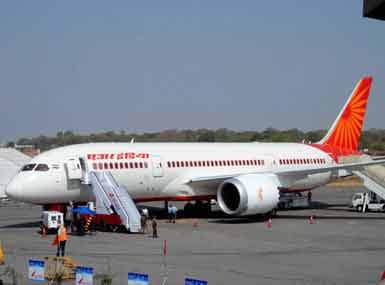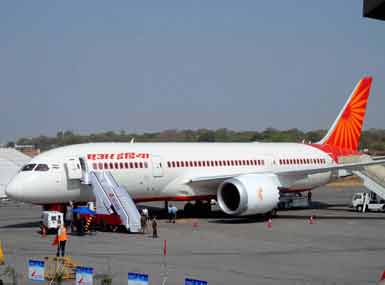New Delhi: Air India’s international operations are bleeding it dry. Though Air India is the longest serving legacy Indian carrier flying to marquee destinations abroad, its domestic operations are earning far better. At least the latest numbers say so. The airline deployed just a fourth of its capacity on domestic routes in 10 months of last fiscal between April and January, but these flights generated 40% of its total revenues. In fact, domestic yields (which means revenue per passenger) were much higher at over Rs 6 when international yields languished at around Rs 3.50. So should Air India deploy more of its capacity on domestic routes? Absolutely. Should it discontinue some of the bleeding foreign routes? Of course. Should it introduce new routes to Europe? Certainly not. Some internal discussions have begun on starting three new routes to Europe. Air India needs a comprehensive restructuring of its network to be able to cash in on its strengths and mitigate weaknesses. Instead of mindless overseas expansion, the airline needs to consolidate its grip on the domestic market if it wants to survive the onslaught of competing airlines like IndiGo (already a formidable force on domestic routes), Jet (which is strengthening domestic operations) and new airline Vistara. [caption id=“attachment_2175575” align=“alignleft” width=“385”]
 Air India. PTI[/caption] To be fair to Air India, it has already done some rejigging of the network. The Delhi-Moscow service, launched in 2013-14, has seen frequencies halved since February. This flight was not even meeting its variable costs. Put simply, this means flights on this sector were not meeting even their fuel costs! The Moscow route was opened in July last year, marked resumption of services by AI after 15 years. So the halving of frequencies, from 4 flights a week to just two a week, shows poor planning and ground work before launching this flight. Then, Air India has also withdrawn a flight on the Delhi-Dhaka route and two flights between Delhi and Ahmedabad. These flights were not meeting their cash costs. Let us look at the latest data available with us: ** 3 in 4 flights on the Air India network were destined for foreign shores between April and January last fiscal but they brought in less than two-thirds of the airline’s revenues. ** It gets even more alarming if we were to consider losses brought in by some of the celebrated overseas connections: ** During the 10 months under review, the airline lost close to Rs 500 crore on the Ahmedabad-Mumbai-Newark connection. ** Another about Rs 200 crore was lost on the Delhi-Sydney-Melbourne flight which was started with much fanfare in 2013-14. ** The Ahmedabad-Mumbai-London flight, which is obviously flying a busy route, raked in losses of over Rs 250 crore. ** Another flight to London, the Amritsar-Delhi-London one, made losses of well over Rs 200 crore. ** In fact, 39 international flights brought in over 70% of the operational loss in 2014-15. It is interesting to note that the Dholakia Committee, which recommended that flights which are unable to meet their variable costs be either axed or restructured, found that this single step will get Air India maximum annual cost savings. In reply to a question in Parliament last month, Minister of State for Civil Aviation Mahesh Sharma listed out a host of cost saving suggestions made by this committee: If fully implemented, these suggestions can save the ailing airline a whopping Rs 3241 crore in annual losses. Not surprisingly, there is no clarity on how many of these suggestions have been implemented by now or if there even exists a timeline by which all of them will be implemented. The single biggest cost saver for Air India is eliminating or restructuring those flights which do not meet variable costs. The Dholakia Committe has calculated savings of Rs 580 crore from this single step each year. The second biggest saver (Rs 450 crore) could be dynamic pricing, something the Minister of Civil Aviation has been asking the airline to take seriously. In a set of guidelines issued late last year, a Gajapathi Raju asked the airline to try and get more business class passengers closet to the flight by offering these high-yield seats at a discount. Again, there is no clarity on whether his directives have been followed. Another big saver could be strict enforcement of excess baggage charges - Dholakia has estimated Rs 350 crore in annual savings by this one measure alone.
Air India. PTI[/caption] To be fair to Air India, it has already done some rejigging of the network. The Delhi-Moscow service, launched in 2013-14, has seen frequencies halved since February. This flight was not even meeting its variable costs. Put simply, this means flights on this sector were not meeting even their fuel costs! The Moscow route was opened in July last year, marked resumption of services by AI after 15 years. So the halving of frequencies, from 4 flights a week to just two a week, shows poor planning and ground work before launching this flight. Then, Air India has also withdrawn a flight on the Delhi-Dhaka route and two flights between Delhi and Ahmedabad. These flights were not meeting their cash costs. Let us look at the latest data available with us: ** 3 in 4 flights on the Air India network were destined for foreign shores between April and January last fiscal but they brought in less than two-thirds of the airline’s revenues. ** It gets even more alarming if we were to consider losses brought in by some of the celebrated overseas connections: ** During the 10 months under review, the airline lost close to Rs 500 crore on the Ahmedabad-Mumbai-Newark connection. ** Another about Rs 200 crore was lost on the Delhi-Sydney-Melbourne flight which was started with much fanfare in 2013-14. ** The Ahmedabad-Mumbai-London flight, which is obviously flying a busy route, raked in losses of over Rs 250 crore. ** Another flight to London, the Amritsar-Delhi-London one, made losses of well over Rs 200 crore. ** In fact, 39 international flights brought in over 70% of the operational loss in 2014-15. It is interesting to note that the Dholakia Committee, which recommended that flights which are unable to meet their variable costs be either axed or restructured, found that this single step will get Air India maximum annual cost savings. In reply to a question in Parliament last month, Minister of State for Civil Aviation Mahesh Sharma listed out a host of cost saving suggestions made by this committee: If fully implemented, these suggestions can save the ailing airline a whopping Rs 3241 crore in annual losses. Not surprisingly, there is no clarity on how many of these suggestions have been implemented by now or if there even exists a timeline by which all of them will be implemented. The single biggest cost saver for Air India is eliminating or restructuring those flights which do not meet variable costs. The Dholakia Committe has calculated savings of Rs 580 crore from this single step each year. The second biggest saver (Rs 450 crore) could be dynamic pricing, something the Minister of Civil Aviation has been asking the airline to take seriously. In a set of guidelines issued late last year, a Gajapathi Raju asked the airline to try and get more business class passengers closet to the flight by offering these high-yield seats at a discount. Again, there is no clarity on whether his directives have been followed. Another big saver could be strict enforcement of excess baggage charges - Dholakia has estimated Rs 350 crore in annual savings by this one measure alone.
Air India needs to retain local flavour, international flights bleeding it dry
Sindhu Bhattacharya
• April 3, 2015, 11:41:40 IST
Air India’s international operations are bleeding it dry. Though Air India is the longest serving legacy Indian carrier flying to marquee destinations abroad, its domestic operations are earning far better. At least the latest numbers say so.
Advertisement
)
End of Article